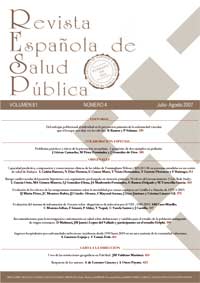Outbreak of viral Parotiditis in a school in Bizkaia, Spain, in 2006
Abstract
Background: Outbreaks of parotiditis have recently been recorded in Spain and in other developed countries. The possible reasons currently under consideration are the low degree of immunization coverage among the populations involved and/or the low degree of effectiveness of the vaccine strains employed. This study describes one outbreak of parotiditis having occurred in Bizkaia and assesses the effectiveness of the vaccine strains and the usefulness of the diagnostic tests currently used. Methods: Those cases having compatible clinical symptoms and an epidemiological link within the period under study (February-May 2006) were labeled as cases. Blood samples were taken to study IgM and IgG and saliva for genotype and RNA detection. The immunization status and the strain used were found through the vaccine distribution records. A univariate analysis was conducted on the data and relative risks calculated according to the vaccine strains used. Results: A total of 63 cases were detected, 52 being students from one school. Fifty percent were 9-13 years of age. A total of 88.5% of the cases detected at the school had been properly immunized. The IgM sensitivity was 9% , PCR sensitivity being 37%. The relative risk of those students immunized with an initial dose of Rubini strain as compared to those immunized with Jeryl-Lynn strain was 3.8 (95% CI:2.27-6.49). Conclusions: The high degree of immunization coverage does not prevent outbreaks from occurring in places having a high degree of exposure. The IgM reveals itself to be sensitive to a very small degree for the diagnosis of parotiditis. It seems necessary that the current immunization strategies and diagnostic methods be reconsidered.Downloads
Published
2008-03-17
Issue
Section
ORIGINALS

